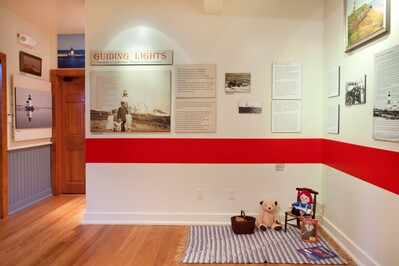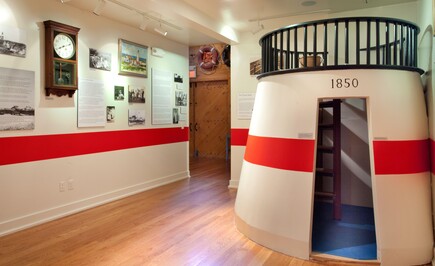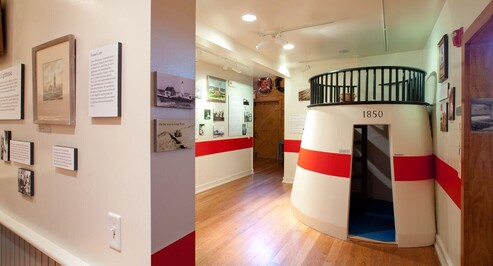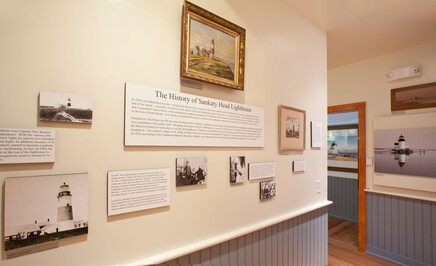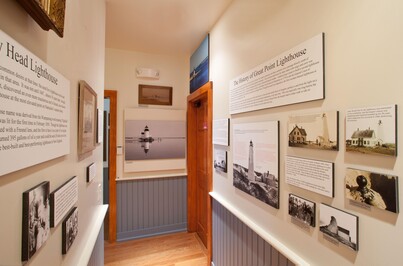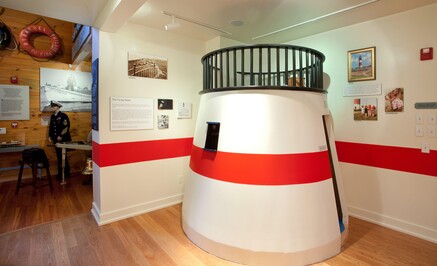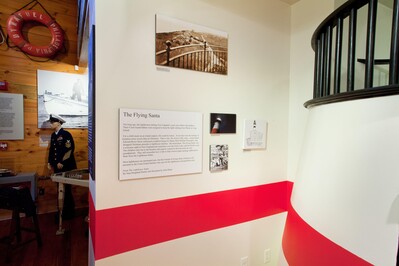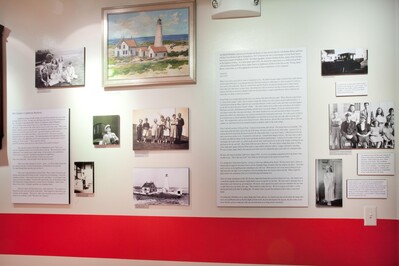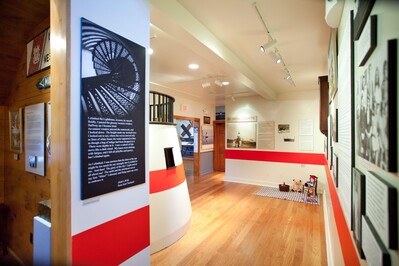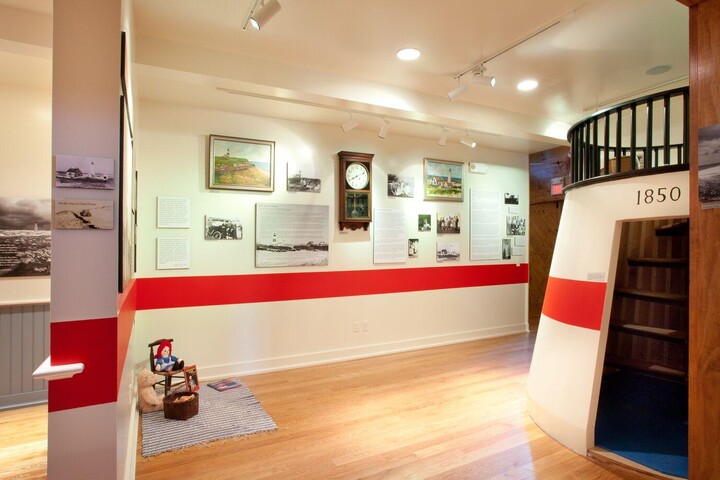
Egan Maritime Institute’s Nantucket Shipwreck & Lifesaving Museum will open Thursday, May 24th with a new exhibit "Guiding Lights: Nantucket's Lighthouses, Keepers & their Families."
This heartwarming exhibition celebrates the island’s historic monuments and the heroic men, women, and children who lived and worked in the lighthouses. For centuries, Nantucket’s lighthouses – Brant Point, Great Point and Sankaty – housed keepers and families, and they were the first true guiding lights for all mariners who traversed the treacherous shoals surrounding Nantucket. “Guiding Lights” revisits a time when the technology that we know today was virtually unheard of and navigational tools were scarce or rudimentary. These welcome beacons of light were quite often, and most assuredly, all that captains of the sea had to rely on in order to sail their vessels to safety. This exhibit features photographs and stories from an era gone by; now, as we continue to embrace the world in which we live, it is important to remind ourselves of these earlier times, when the technology that we know today was practically non-existent.
Brant Point Lighthouse, situated at the entrance to Nantucket harbor and named for the Brant geese that once populated the area, is the second oldest lighthouse in America. Preceded in age only by Boston Light, this well-loved structure, though more short and squat than all other lighthouses in New England, has seen Nantucket through the American Revolution, the whaling industry and the growth of tourism, with many physical changes and repairs in between. First built in 1746, and rebuilt eight times since, this now-famous light has been memorialized by artists, photographers and authors for the last several centuries, lending itself to the romanticism and good luck talisman it has become in recent years. Those who leave the island must know that to throw a penny overboard as one rounds the lighthouse by sea guarantees a safe return to the beloved island.
Prior to the opening of the Cape Cod Canal in 1914, the route of choice for coastal commerce for three centuries was a passage directly north of Great Point – a passage between Nantucket Sound and the Massachusetts mainland. This well-traveled route for ships laden with cargo and crew was one of the most dangerous tracts of water – with ever-changing tidal currents, shoals and harsh weather – and underscored a need to build a second lighthouse on Nantucket (Brant Point being the first). With this thought in mind, a committee was formed on Nantucket in 1770 to ask the General Court of Massachusetts to build a lighthouse at Great Point, once known as Sandy Point. Though the need was imperative, the first wooden-framed lighthouse at Great Point was not completed until 1785.
Anyone who has been to Great Point Light or has seen it from the air or the sea must surely know or can imagine, getting to and from the light on a daily basis, especially in the winter months of wind, snow, rain, and frigid temperatures, is no easy feat. This was especially true long before the invention of the automobile, and for the first few years when there was no keeper’s house at Great Point, the keepers had to either walk or ride on horseback from Wauwinet to get to the lighthouse every day, a distance of seven miles each way.
In 1838, an unidentified mariner, writing in the Boston Post, expressed what was a common desire at that time: the need for a lighthouse on the east end of the island – essentially in order to warn sailors of the most dangerous shoals in that area. It was not until 1847, almost 10 years later, that Lieutenant Charles Davis, while conducting sounding operations off Nantucket, discovered an even more treacherous reef of shoals, now known as the Davis South Shoals. His discovery prompted the process of erecting a lighthouse at the most elevated point on Nantucket’s eastern shore.
Situated on a bluff that rose 90 feet from the beach below, Sankaty Lighthouse, whose name was derived from the Wampanoag word meaning “Highland”, was completed in December 1849. Originally built upon a ring of cobblestones, it was lit for the first time in February 1850. Though the lighthouse was the third to be built on Nantucket, it was the first lighthouse in America to be outfitted with a Fresnel lens, and the first to have it as a part of its original equipment. The original “single-wick” whale oil lamp within the Fresnel lens consumed 395 gallons of oil a year and could be seen 20 miles out at sea. In 1852, according to the Lighthouse Board at the time, Sankaty was considered the best-built and best-performing lighthouse in New England.
In the 19th century French physicist and engineer, Augustin-Jean Fresnel, developed a new multi-lens to be used in lighthouses. He incorporated the refractive properties of glass with the use of a central thick lens called a “bull’s eye”, and supplemental prismatic rings assembled about it in a series of steps called echelons. By maximizing the amount of light created with the use of this magnifier and the prisms, the Fresnel lens revolutionized lighthouse illumination around the world.
By celebrating these historic monuments, and their past keepers and families, we are proud to share with you the stories and photographs of their everyday life – a life that no longer exists here on Nantucket. Some of these stories are documents of simple daily occurrences, while others tell true tales of shipwreck sightings and salvage at sea. All pay tribute to the strength and greatness of these remarkable lighthouses and the heroic men, women and children who lived and worked in them.
Without the valuable time, kind help, creative input and dedication to this project by the following people and businesses, this exhibit would not have been possible.
- Jeff Allen
- Rob Benchley
- Karen T. Butler
- Cheryl Killen Coffin
- Jeremy D’Entremont
- Tony Dumitru
- EganSign
- Robert Frazier
- Suzanne Gardner
- Bill Grieder
- Ruthie Chapel Grieder
- Marie (Ralph) Henke
- Sara Hoagland Hunter
- Peggy Kaufman
- Carl Keller
- David Lazarus
- Karol Lindquist
- Leslie Linsley
- Marine Home Center
- Louise Martling/Eleventh Hour Design
- Tori McCandless
- Ben Moore/Moore Woodworking, Inc.
- Nantucket Historical Association
- Blake Richard/Nantucket Frameworks
- Laurie Killen Paterson
- Ben Rudd
- Edwin Rudd
- Sharlene Rudd
- Glenn Speer
- Paul Wolf


